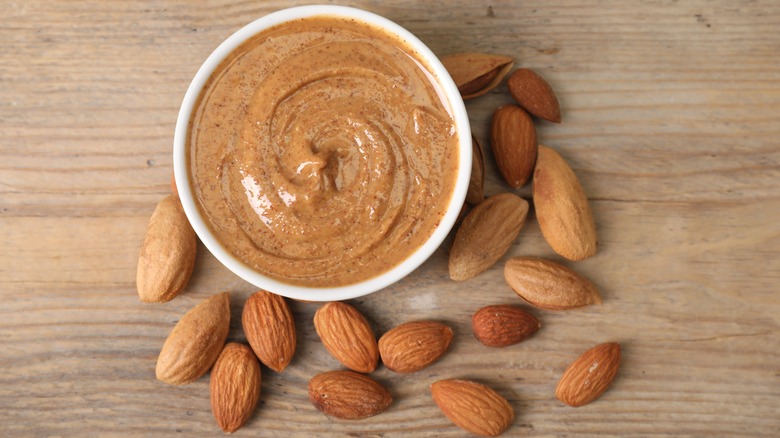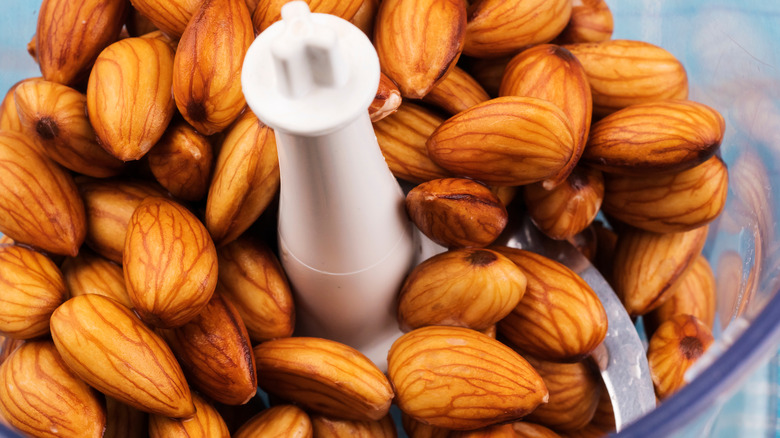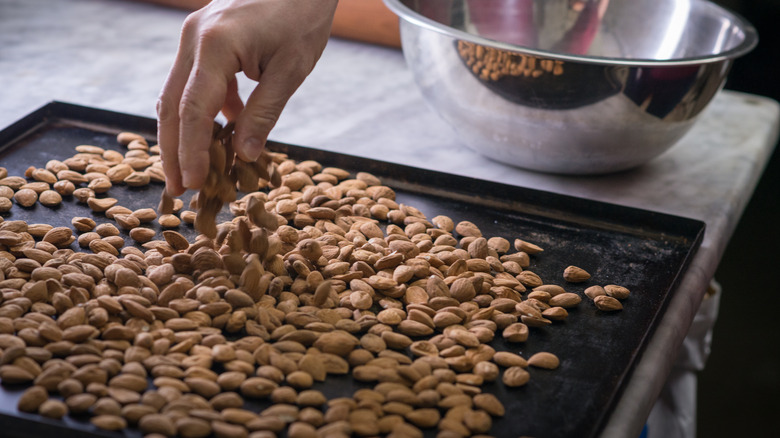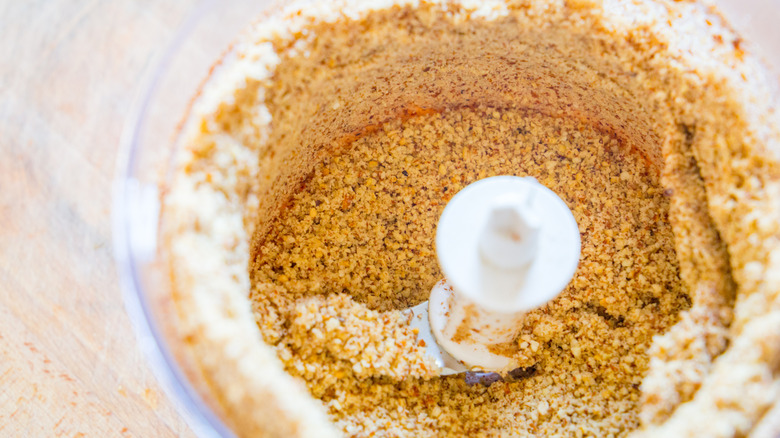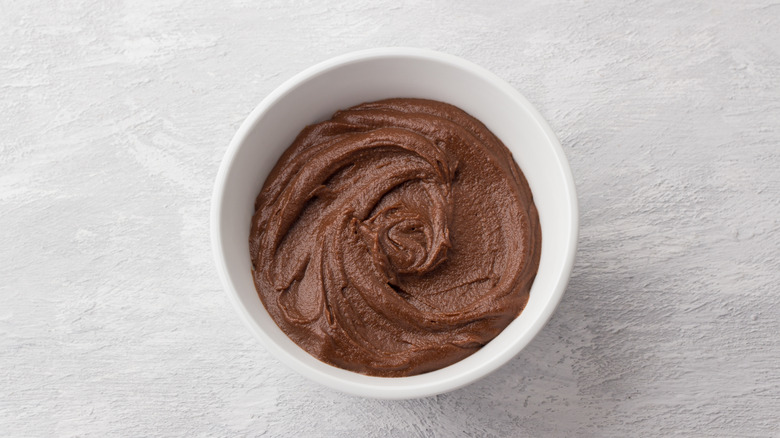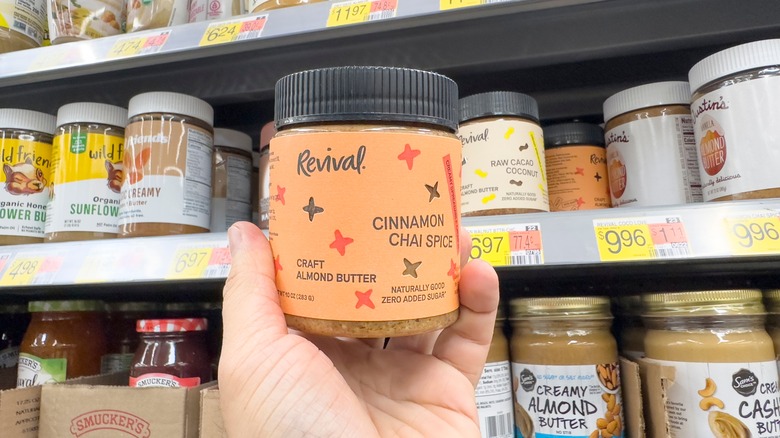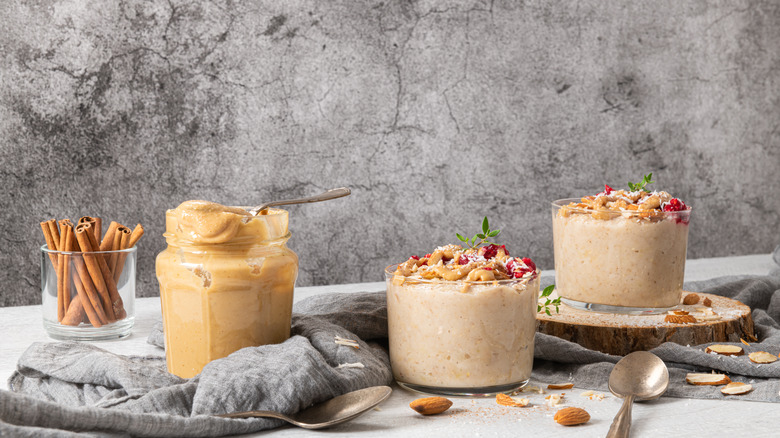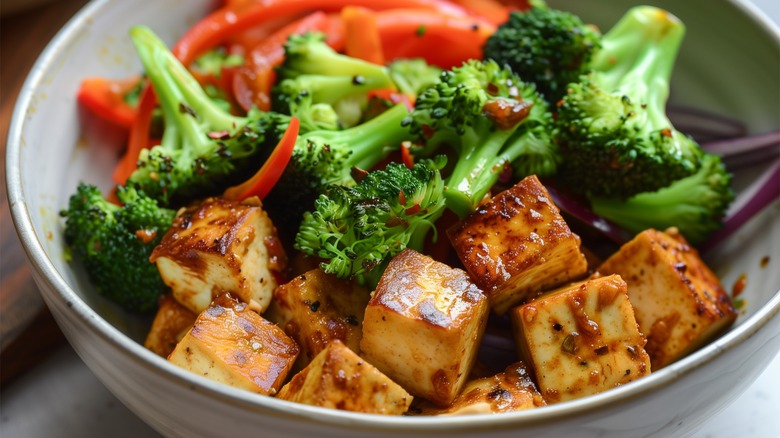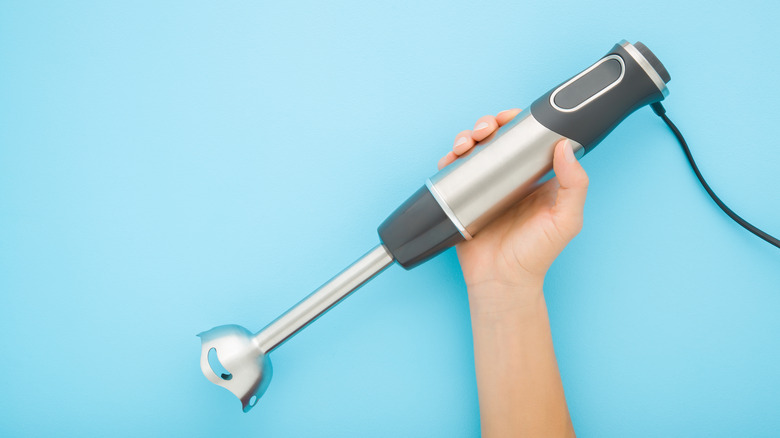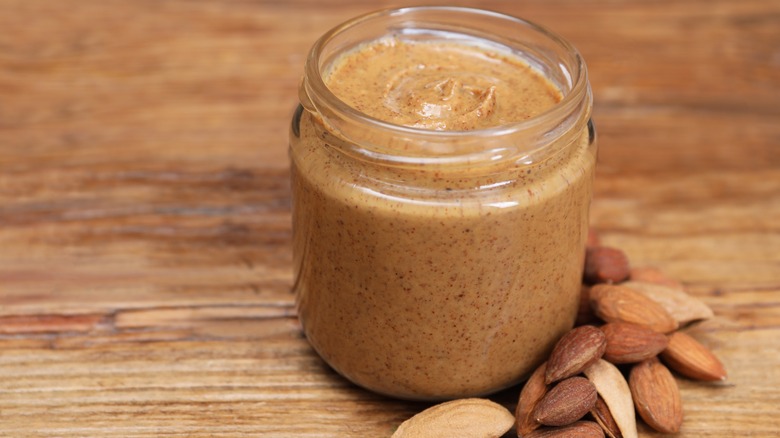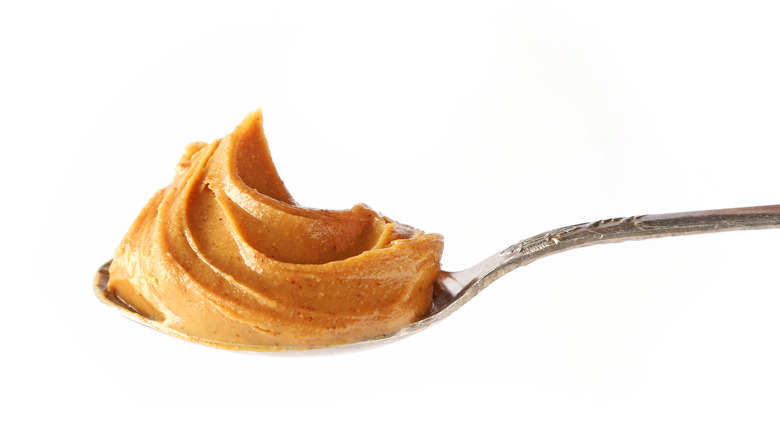Mistakes Everyone Makes With Almond Butter
While there are many types of nut and seed butters available, some get more airtime than others. Peanut butter will probably always be the fave, but almond butter is another popular choice. However, some people may get put off because they're not sure how to use it in the best ways possible. There are some mistakes everyone makes with almond butter — and learning how to fix them can really turn things around for anyone on the fence about it.
Some of these mistakes are relevant when you're making almond butter from scratch. With a little know-how and the right equipment, it's easy to make your own, but it can go wrong in various ways. Other mistakes are related to using, cooking with, or storing almond butter, whether it's store-bought or homemade.
Not only have we identified these issues, but we'll also explain how to avoid them or fix them. So, if you've been struggling with almond butter, you're in the right place. It's simple to make from scratch and easy to cook with, too. Once you know where you're going wrong, it'll be plain sailing.
Using too few almonds when making your own nut butter
Nut butters are more nutritious than many people think. However, almond butter can be pricey. Plus, some grocery store versions are filled with palm oil and other additives you might not be happy about. That's why some people try to make it from scratch. If you've tried making your own almond butter and it just won't come together, it could be because you're not using enough almonds.
It's not that there's literally a minimum amount of almonds you need to form a butter. Rather, the width of the bowl or jug and the positioning of the blades in some blenders and food processors means that it just doesn't work with too few nuts. The blades will spin, but most of the almonds will be underneath them, so they won't get pulverized and eventually form nut butter.
So, what quantity of nuts do you need? This depends on the size of your blender jug or food processor bowl and the blade positioning. A Vitamix blender, for instance, needs around 4 cups of almonds for the blades to do their thing properly. Other blenders or full-size food processors may only need 3 cups, while mini food processors will work with just 1 to 2 cups. The almonds should fully cover the blades before you start processing.
Not roasting almonds for extra flavor when making almond butter from scratch
If you aren't roasting almonds before you use them to make almond butter, you should rethink things. You might assume you just chuck raw almonds into a blender or food processor with the other ingredients, but that's not the way it goes. Your almond butter will taste way better with roasted nuts but there are other benefits, too.
The roasting process brings out a nuttier, more complex taste profile that many people find more appealing than raw almond butter. When you buy almond butter from the store, it's almost definitely made from roasted almonds. You might be surprised at how different it tastes when it's made with raw almonds. Several chemical reactions occur during the heating process. The most significant change comes from the Maillard reaction, which happens when amino acids and sugars in the almonds are exposed to heat. This reaction produces hundreds of different flavor compounds. It creates the characteristic nutty, toasted flavor you expect from almond butter.
Beyond flavor, roasting offers a few additional benefits. It can make the almonds easier to process into a smooth butter, as the heat brings out the natural oils and softens the nuts slightly. When you don't use roasted nuts, you'll need to use more oil to get a paste to form. You may also need to soften the almonds in other ways, such as by soaking them.
Being impatient when waiting for homemade almond butter to come together
Being impatient when making homemade almond butter is a common pitfall that can lead to frustration and failed attempts. Creating smooth, creamy almond butter is a process that takes time and patience. You might become discouraged when your mixture appears dry and crumbly, thinking you've done something wrong. But, don't throw away that mixture just yet. It can take some time for almond butter to come together. So long that you think it never will. Be patient and you'll eventually get where you're aiming.
Almond butter goes through several stages before it's done. Initially, the ground almonds will resemble a coarse meal or flour. As you continue processing, the mixture will start to clump together slightly. After this, it can form a ball that clumps together up the sides of the blender jug or processor bowl. It can really look like something's gone awry and the mixture will always be this thick.
You just need to keep on processing the almonds. The heat generated from the food processor or blender helps to break down the nuts further, releasing more oils. When you least expect it, the mixture will transform. It will become glossy and start to flow smoothly. This is your sign that you've achieved the perfect almond butter consistency. When it seems like you've gone wrong, trust in the process. Depending on your blender or food processor, it can take between five and 15 minutes.
Thinking almond butter always has to be plain
Basic almond butter is a simple spread. Roasted almonds, a sprinkling of salt, perhaps a little oil if needed to make it smooth. But, it doesn't have to always be this way. Sure, regular almond butter is great. However, if you think it always has to be plain, you're missing out on some tasty possibilities.
Adding a touch of vanilla extract to homemade almond butter brings an extra dimension of flavor. It's especially good if you're planning to use it in sweet recipes. You could also experiment with other extracts, although some pair better with almonds than others. For those with a sweet tooth, adding a little sugar or honey is another nice touch.
Chocolate lovers shouldn't feel left out, either. Chocolate almond butter is a delicious combination, and making it at home is surprisingly simple. You just add cocoa powder or melted dark chocolate to your almond butter recipe. It turns out a little bit like an almond version of Nutella. However, you don't necessarily have to make it at home. Many stores now sell chocolate almond butter, and occasionally other flavored options.
Assuming all store-bought almond butter is the same
You go to the store to buy almond butter and end up picking up whichever you come across first or perhaps you choose the one that's on sale. It's all the same, right? Actually, you might end up disappointed. The truth is, there can be significant differences in taste, texture, and quality between various almond butter brands and varieties.
What you might notice straight away is a difference in taste. Some almond butters are rich and nutty, while others may taste bland or slightly bitter. This might be down to the quality of almonds used, roasting methods, or the addition of other ingredients. If in doubt, we've ranked popular almond butters from worst to best to help you find the ones that are worth buying.
Texture is another important factor. Some brands are smooth and creamy. Others are chunky with almond pieces included. The consistency can range from runny to thick and spreadable, depending on how it's processed and what oils are added. Ingredient lists can vary between brands, too. Some offer pure almond butter with no additives, while others might include salt, sugar, oils, or flavorings.
You might also have certain ethical considerations when buying. Maybe you only choose products that are fair trade or sustainably sourced. Alternatively, you could be on the lookout for organic almond butter. It's good to realize not every jar is the same and look out for options that not only taste good but fit any other requirements you have.
Thinking almond butter is only good for toast
Think almond butter is just for toast? Think again! There are so many ways you can use this spread, and they go way beyond slathering it on a slice of sourdough. It's a mistake to think it isn't a versatile ingredient. It means you'll miss out on some brilliant uses for it.
In baking, almond butter adds moisture and richness to cookies, brownies, and muffins, often serving as a healthier alternative to butter or oil. It's particularly useful in vegan and gluten-free baking, where it can help bind ingredients together. It's great in everything from wholesome treats like protein bites to more decadent ones, like almond butter cups. You can use it in frosting or melt it and drizzle it over ice cream.
It's also perfect for adding to smoothies and protein shakes. It contributes healthy fats and protein, not to mention a rich, creamy texture. If you're feeling snacky, almond butter pairs well with apple slices or celery sticks. It can be used to make energy balls or bars, or enjoyed on crackers or rice cakes. If you're in the market for breakfast options beyond toast, you can stir almond butter into oatmeal, use it as a topping for pancakes or waffles, or add it as an ingredient in your homemade granola. All in all, it's way more versatile than most folks realize. That's why you need almond butter in your pantry at all times.
Ignoring savory almond butter recipes
Another error you can make is assuming almond butter is only good for sweet recipes. In actual fact, it's great in savory dishes, too. There are so many ways to use it beyond the realm of sweet recipes that you'll be going through jars faster than you can replace them.
Almond butter adds depth, richness, and a subtle nutty flavor to a variety of dishes. One popular use is in sauces and dressings. For instance, you can whisk it into a vinaigrette to create a creamy salad dressing. In Asian-inspired cuisine, you can use it in place of peanut butter in satay sauces, which is not only great to mix things up but also for anyone allergic to peanuts. You can also add almond butter to jarred salsa (or homemade) to level it up.
It's also a fantastic addition to soups and stews. A spoonful stirred into a butternut squash soup can make the dish more rich and complex. It's a particularly good choice in vegan soups, where it can contribute a creamy texture without the need for dairy. What's more, you could use it as a replacement for peanut butter in an African peanut stew. It's delicious as a sauce or marinade for crispy baked tofu. For a quick and easy pasta sauce, thin almond butter with pasta cooking water and season with garlic, lemon juice, and herbs. And, these ideas are just a few of many.
Not using almond butter to fix too-spicy dishes
Did you know you can use almond butter to tame the heat in spicy dishes? If it's not a method in your repertoire, you're missing out. This technique is particularly useful for anyone who enjoys the flavors of spicy cuisine but is overwhelmed by too much heat. What's more, nut butter can be used to help fix too-spicy dishes where you've been overly heavy-handed with hot peppers.
The fat content in almond butter is key to this. Capsaicin, the compound responsible for the spicy sensation in peppers, is oil-soluble. When you add almond butter to a spicy dish, its fats bind with the capsaicin molecules, helping to distribute them more evenly throughout the dish. This dispersion can make the heat feel less intense on the palate. Then, there's the fact that almond butter's creamy texture can coat the mouth, creating a barrier between the spicy elements and your taste buds. This coating makes the spiciness of the dish seem less powerful, even if it's technically just as hot.
To use almond butter to fix a spicy dish, start by stirring in small amounts at a time. For a curry or stew, you might begin with a tablespoon or two, mixing it in thoroughly and tasting it before adding more. In a stir-fry or noodle dish, you could dilute almond butter with water or broth to help evenly distribute it.
Making a mess when stirring almond butter that has separated
Almond butter separation happens all the time, especially in natural or homemade varieties that don't contain emulsifiers or stabilizers. It occurs because the natural oils in almonds rise to the surface over time. This leaves a layer of oil on top and a denser almond paste below. It's totally natural and doesn't mean there's anything wrong, but it can be annoying to deal with. And, many people make the mistake of trying to stir it back together, which is messy.
The most common way to fix separated almond butter is just to stir it with a spoon or knife. But, this often causes oil to spill over the sides of the jar, making a mess. It's not just messy but can also cause you to mix it unevenly, leaving some parts of the butter too oily and others too dry. There is, however, a mess-free way to fix separated nut butter.
The easy fix for this problem is to store the jar upside down. By doing this, the oil that would normally rise to the top is forced to travel through the entire jar, naturally redistributing itself throughout the butter. When you flip the jar right-side up to use it, the oils will be more evenly distributed. That said, if you prefer a more active approach or are dealing with particularly stubborn separation, try using an immersion blender. It lets you quickly and thoroughly blend the oil back into the almond butter without making a mess.
Storing almond butter incorrectly
One of the most common mistakes people make with almond butter is storing it incorrectly. You're probably used to storing your peanut butter in the pantry. But, does the same go for almond butter? Well, it depends.
If you've chosen a natural almond butter or you've made it yourself, you should probably store it in the fridge. Yes, it's a bit annoying. However, the layer of oil that separates out from the almond butter can go rancid. This is a particular issue in warm weather or if you keep your almond butter close to the stove where it gets warmed up when you cook. Rancid oil tastes unpleasant and could ruin whatever you make with your almond butter.
If you choose almond butter that's more similar to everyday peanut butter, with stabilizers and ingredients such as palm oil to give it a consistent texture, it doesn't need to go in the fridge. These kinds of almond butters don't separate, so there's no chance of them going rancid.
The trouble with keeping almond butter in the fridge is that it can sometimes make it too hard to spread. This depends on the brand, though, because some are quite runny and are actually easier to spread after being chilled. Either way, if you find chilling your almond butter annoying, it's worth noting that it isn't dangerous to eat it if the oil goes rancid, it just affects the flavor. So, it might be worth the risk.
Letting almond butter stick to your measuring spoon or cup
When you're cooking with almond butter, you might be using a spoon or measuring cup to get the right amount. But, the trouble is that it can stick to the measuring utensil. Luckily, there's a simple way to stop ingredients from sticking to your spoon – and if you don't use it, you're making a mistake.
First of all, why is it an issue if almond butter sticks to your measuring cup or spoon? Well, the major issue is that some is left behind, so your measurements might end up off. Some recipes are forgiving enough that it won't make much of a difference, but others call for total precision. Of course, another issue is that it's a waste when almond butter gets left on the spoon or in the cup, and it isn't exactly cheap. Plus, if you want to measure any other ingredients, the measuring tool will need more than just a wipe, you'll need to thoroughly clean it, which can be annoying.
The trick is to coat your spoon or measuring cup in a little oil or cooking spray before you get started. This way, you can measure it out into your recipe and it'll just slip right off. You'll minimize wastage, your measurements will be more precise, and you'll spend less time doing dishes. That sounds like a win.
